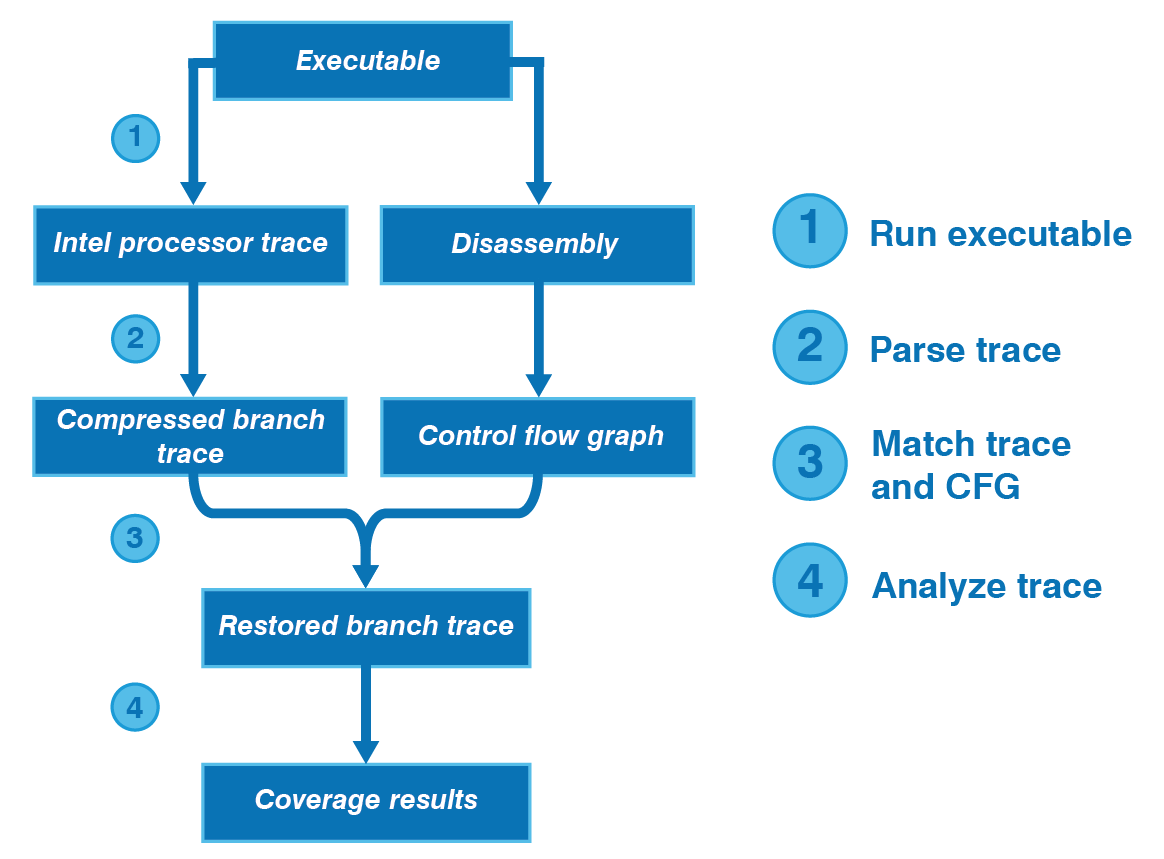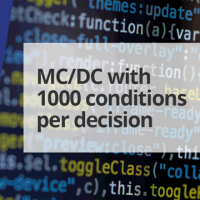Typically, to collect structural coverage results from software tests, you apply instrumentation to source code. But what if you can't apply instrumentation (because you only have access to object code), or just don't want to (to reduce instrumentation overheads and ensure that what you test is what you deploy)?
In this blog, we'll explore some methods we’ve been developing to perform instrumentationless code coverage analysis by using branch traces – traces generated from program execution that contain information on which branches were taken. The methods include one using a machine emulator (QEMU), and another using hardware (Intel Processor Trace).
Zero-instrumentation coverage on an emulator
We modified QEMU, an open source machine emulator that supports multiple popular operating systems, to collect coverage without instrumentation. To do this, we made the emulator produce a branch trace when it runs, which we can later parse to determine which elements of the object code were executed.
We compile the test program to an ELF file, so it runs “bare metal”, without an OS. If we didn’t do this, the generated trace would contain all the branches that executed in the kernel as well as in our program, and we would have to remove this data from the trace before subsequent processing.
We then run the trace through RapiCover to produce a coverage report. Figure 1 demonstrates the overall process on a snippet of code from the project.
Zero-instrumentation coverage on hardware
Okay, so we can collect coverage data without instrumentation from a simulator we have full control over – can we do the same from physical hardware, where we don’t have that control?
To explore this, we used Intel Processor Trace (IPT), a feature built into newer Intel chipsets that lets you collect branch trace information from CPU cores.
We turn on IPT via the Linux perf tool, and then run our program. Next, we use the IPT C library to decode the output data and produce a branch trace in a format that our tools can read.
IPT compresses data to reduce performance overheads, storing only whether each branch is taken or not. We can’t use the compressed data directly, as it isn't clear which branch is taken. To restore this information, we disassemble the program, generate a control flow graph (CFG) from the disassembly, and match elements in the CFG to the IPT trace.
Again, we use RapiCover to analyze the results. Figure 2 shows the overall process.
Figure 2. Process for collecting coverage via Intel Processor Trace
Closing remarks
A benefit of using branch traces to analyze structural coverage is that it means we can collect coverage from any executable written in any language, as long as we can obtain a disassembly of the object code. The programs we used while developing the Intel Processor Trace method, for example, were written in assembly language!
We’re continuing to explore new methods to collect coverage data with zero instrumentation. If you’re interested in obtaining zero-instrumentation coverage of your code, contact us to see how we can help.

 Rapita System Announces New Distribution Partnership with COONTEC
Rapita System Announces New Distribution Partnership with COONTEC
 Rapita partners with Asterios Technologies to deliver solutions in multicore certification
Rapita partners with Asterios Technologies to deliver solutions in multicore certification
 SAIF Autonomy to use RVS to verify their groundbreaking AI platform
SAIF Autonomy to use RVS to verify their groundbreaking AI platform
 What does AMACC Rev B mean for multicore certification?
What does AMACC Rev B mean for multicore certification?
 How emulation can reduce avionics verification costs: Sim68020
How emulation can reduce avionics verification costs: Sim68020
 Multicore timing analysis: to instrument or not to instrument
Multicore timing analysis: to instrument or not to instrument
 How to certify multicore processors - what is everyone asking?
How to certify multicore processors - what is everyone asking?
 Certifying Unmanned Aircraft Systems
Certifying Unmanned Aircraft Systems
 DO-278A Guidance: Introduction to RTCA DO-278 approval
DO-278A Guidance: Introduction to RTCA DO-278 approval
 ISO 26262
ISO 26262
 Data Coupling & Control Coupling
Data Coupling & Control Coupling
 DASC 2025
DASC 2025
 DO-178C Multicore In-person Training (Fort Worth, TX)
DO-178C Multicore In-person Training (Fort Worth, TX)
 DO-178C Multicore In-person Training (Toulouse)
DO-178C Multicore In-person Training (Toulouse)
 HISC 2025
HISC 2025


















